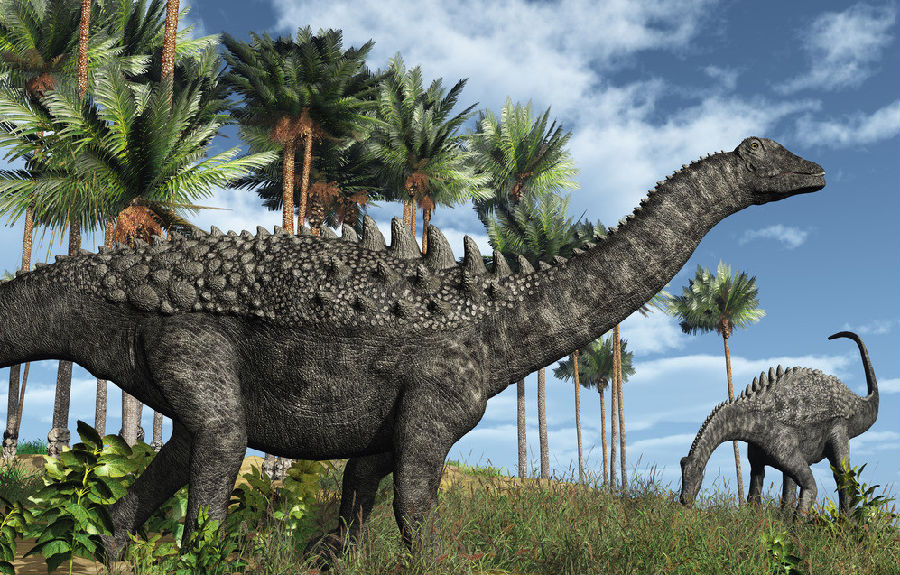All around the world, birds, like dinosaurs, fill just about every habitat in every environment, from the rainforest to the mountains to the seacoast.
全世界范围内,如同恐龙一样,鸟类居住在各式各样的环境当中,从雨林到山地,再到海岸。
An ostrich, nearly 3 meters tall and over 135 kilos, is the largest modern bird.
鸵鸟,几乎高达三米,重达一百三十五公斤是现今最大的鸟类。
That may pale in comparison to a Tyrannosaurus rex or the giant Sauroposeidon.
这与霸王龙或者巨型的波塞东龙相比可能苍白无力。
But the biodesigns which give birds their ability to get up in the air, to maneuver in flight, and to reproduce are clearly found in dinosaurs...genetic traits that once allowed dinosaurs to grow to mammoth proportions or survive in a world of brutal killers.
但是使鸟类能够飞行翱翔的身体设计以及繁殖方式都有恐龙的影子,这些遗传性状曾经一度帮助恐龙长成庞然大物或在杀手林立的世界里生存。
Features honed by 165 million years of evolution simply never went away.
这些经过一亿六千五百万年进化洗礼的特征不会轻易消失。
Tools that once served dinosaurs so well have adapted to serve new functions in modern birds.
那些曾经服务于恐龙的工具继续为现代鸟类服务。

Dinosaurs used hollow bones to grow very large. Birds use them to save weight.
恐龙利用中空的骨骼成长。鸟类用它减轻重量。
Dinosaurs used air sacs to move air along their massive necks. Birds use air sacs to stay aloft for long periods.
恐龙利用气囊使空气在庞大的颈部流动。鸟类利用气囊保持长期高空飞行。
So in many ways the only difference between dinosaurs and birds is scale.
所以从很多方面讲恐龙和鸟类的唯一区别就在于体积。
And there's even evidence that many terrestrial dinosaurs nearly had what it takes to fly.
甚至有证据表明很多陆生恐龙几乎具备飞行的条件。
In fact, the arms and hands of Deinonychus worked remarkably like a bird's wings.
事实上,恐爪龙的前臂和爪子与鸟类的翅膀非常相似。
For Deinonychus, this high-speed motion creates a grasping claw able to dig deep into flesh.
对于恐爪龙,高速运动造就了深深刺入血肉的利爪。
In a bird, this same feature allows its wings to flap at those same high speeds...the key to flight.
而对于鸟类,同样的因素使翅膀能够告诉拍打,这是飞行的关键。
Deinonychus' arms were very specialized, much like modern birds.
恐爪龙的前臂非常专一化,酷似现代鸟类。
In fact, like a modern bird, they have the ability to fold their arms, or their wings, if you will, to the side.
事实上,如同现代鸟类,它们有能力将前臂或者说两翼弯曲到一侧。
This is the same folding ability that allows birds to fly today.
这与今天鸟类飞行的折翅能力如出一辙。
The wings of a bird in flight are a living example of Deinonychus' claw in action. Look at a bird out in nature.
鸟类飞行时的翅膀就是恐爪龙利爪运动时的翻版。看看自然界的鸟类。
As it's moving its wings back and forth, the pattern of the joints and the angle of the joints in the wings of birds closely match the pattern we see in Deinonychus.
随着它们来回拍打翅膀,其关节模式以及两翼关节的角度与恐爪龙的十分吻合。
And there's one final clue... A clue that all but definitively connects birds and dinosaurs, and it's something you'd least expect... Something scientists call the furcula. Or wishbone.
还有一个终极线索...能够充分证明鸟类和恐爪龙的联系,这也是最让人感到意外的...科学家称之为叉突。或是叉骨。
Wishbones today only exist in birds, yet virtually every one of the most ferocious carnivorous dinosaurs had one.
现今,叉骨只存在于鸟类之中,然而所有凶残的肉食恐龙也都具有叉骨。
In the end, the evidence points to one single conclusion...the mighty T. Rex...the wily Deinonychus...the graceful Quetzalcoatlus...the giant Sauroposeidon...were all just supersized birds.
最终,所有证据指向同一结论...强大的雷克斯霸王龙...狡猾的恐爪龙...优雅的披羽蛇翼龙...还有巨大的波塞东龙...都是巨型鸟类。
So, next time you sit down, ready to carve that Thanksgiving turkey, just imagine what that bird's great-great-great-great grandparents could do to you.
所以当你下次在餐桌前准备切开感恩节火鸡时,想想这只鸡的曾曾曾曾祖父母会把你怎么样吧。


